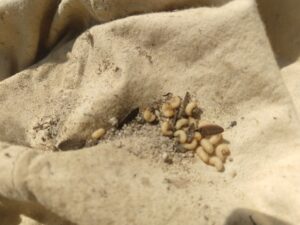Most beds are either out of bloom or should be coming out of bloom soon. If Sparganothis fruitworm trap counts have been high and you haven’t already treated, you should consider doing so in the next few days after honey bees are removed to prevent damage to berries. The best post-bloom treatment options are Diazinon, Intrepid, Altacor, or Delegate. All treatments for lepidopteran pests should be completed before the end of this week to avoid significant fruit injury. Additionally, please monitor the weather conditions, as there will be several rainy days this week.
Root-feeding Pests of Cranberries
If your beds show damage caused by root-feeding insects, you should consider treatment with Imidacloprid (e.g., Admire Pro, Alias 4F, Alias 2F) after bees are removed. The presence of root-feeding insects will be indicated by dead patches (see Picture 1). Pull up dead vines and search through the root zone and soil for grubs and worms. Imidacloprid (Admire Pro or other generic insecticides) is labeled for controlling cranberry rootworm, white grubs (Phyllophaga spp.), and other scarabs in cranberries.
White grubs, Phyllophaga spp. Several species of white grubs infest cranberries in New Jersey, with P. georgiana being the most abundant. These grubs are C-shaped and often found near bog margins.

Picture 1. Damage caused by root-feeding insects.
The adults are reddish-brown and nocturnal. While the grubs attack cranberry roots, the adults have not been reported to feed on cranberries (see Picture 2 of grubs and adults in cranberries). The life cycles and abundance of white grub species in New Jersey are not well known. However, it is likely that Phyllophaga grubs have a 3-year life cycle based on previous reports and our observations. Eggs are laid in late June and July, hatching in July. First instars can be found in late July and August, turning into second instars by the end of August to September. The second instar grubs will overwinter. The following year, these grubs will feed until June and molt into third instars, which will overwinter again. In the subsequent year, the third instars will feed for a while before pupating in June. Pupation occurs in July-August, with adults appearing in the soil in August-September. These adults will remain in the soil and overwinter, emerging in June to mate and lay eggs, thus completing the cycle.
Cranberry rootworm (Chrysomelidae). Pupation starts in late May, with beetles emerging in early June. Adults (see Picture 3) are nocturnal and

Picture 2. Developmental stages of Phyllophaga georgiana.
hide in leaf litter, but can be easily picked up with a sweep net. Females feed on foliage before laying eggs. Young larvae feed on roots, with feeding continuing until October. In the fall, the mature larvae (see Picture 4) move down into the soil to overwinter. Holding water will delay the onset of pupation. The rootworm has a 1-year life cycle. Entomopathogenic nematodes (Heterorhabditis bacteriophora) can be used to control cranberry rootworm.
Use of Imidacloprid. If treatment is needed, use Imidacloprid (Admire Pro or other generic insecticides such as Alias 4F) to control white grubs and rootworms. Imidacloprid is most effective against early (1st-2nd instar) grubs and should be applied after bees are removed from the beds. Due to the 3-year life cycle of these pests, treatment should be continued for 2-3 consecutive years to ensure effective control. Imidacloprid, a neonicotinoid insecticide, is registered for use in cranberries against cranberry rootworm and scarab grubs. This insecticide acts as a contact and stomach poison, affecting the insect nervous system. It is highly systemic and toxic to honey bees, so it should only be used as a post-pollination insecticide. Imidacloprid can be applied by ground or by chemigation, but aerial application is prohibited. The insecticide has a long residual activity (over 100 days) as long as it is not directly exposed to the sun.

Picture 4. Cranberry rootworm larvae.

Picture 3. Cranberry rootworm adult.

